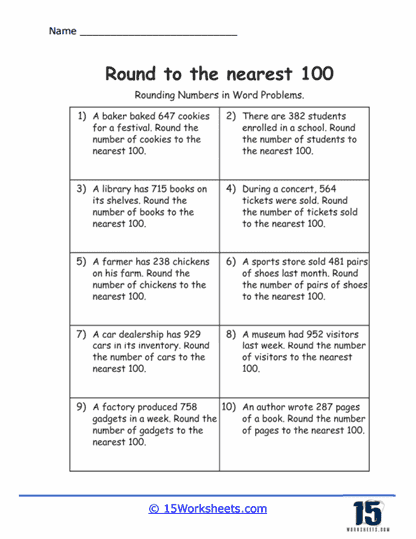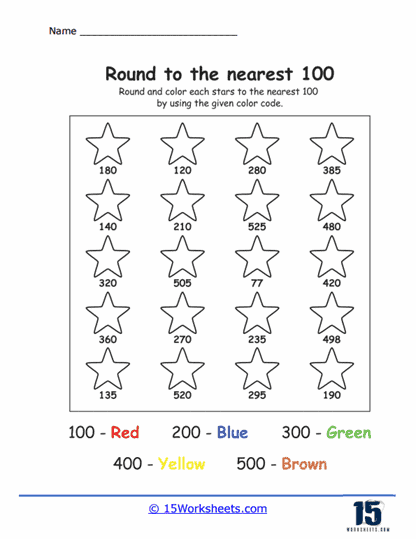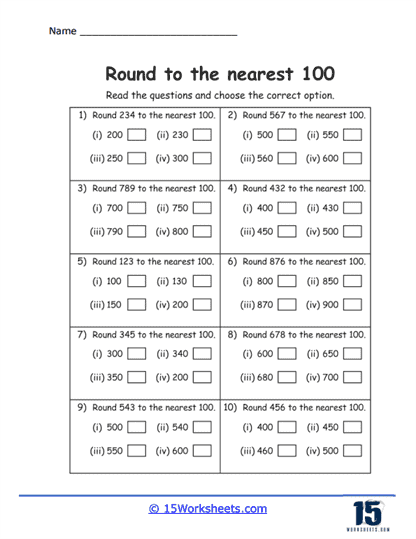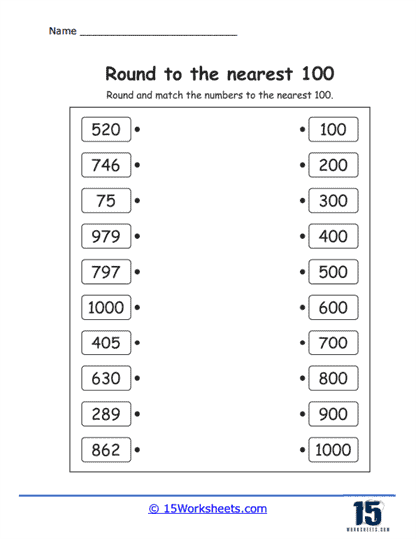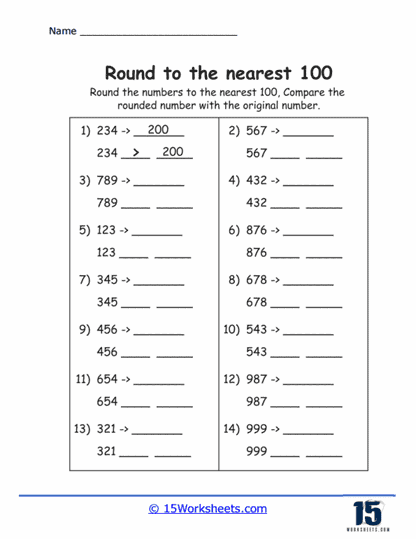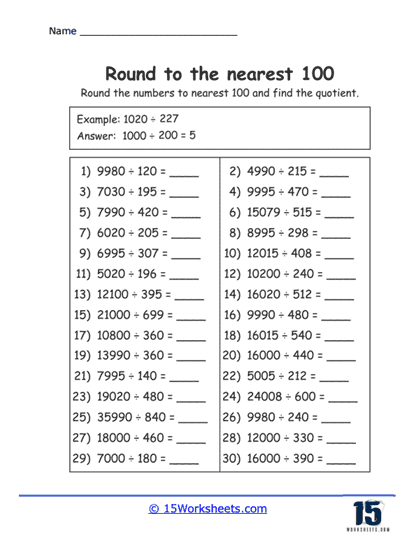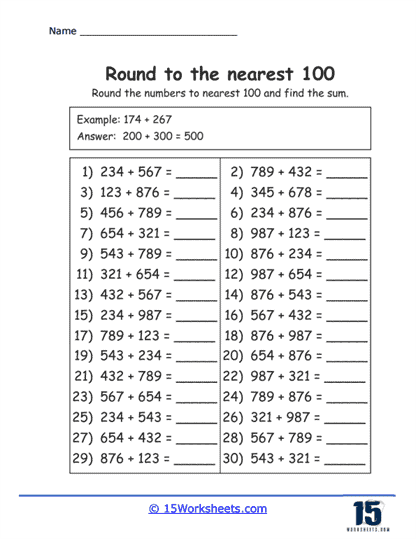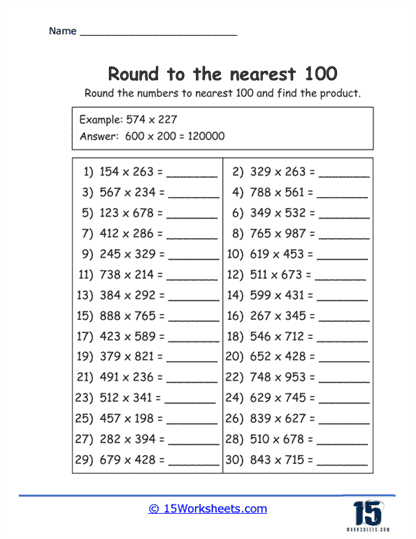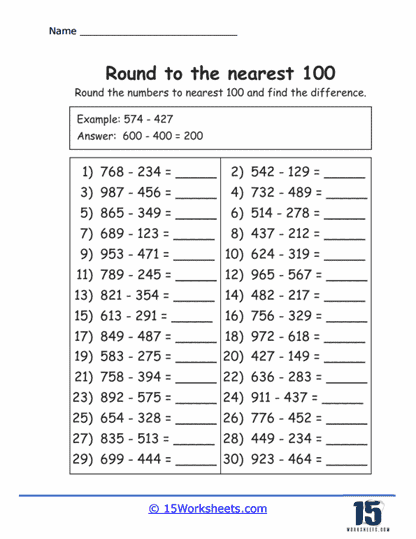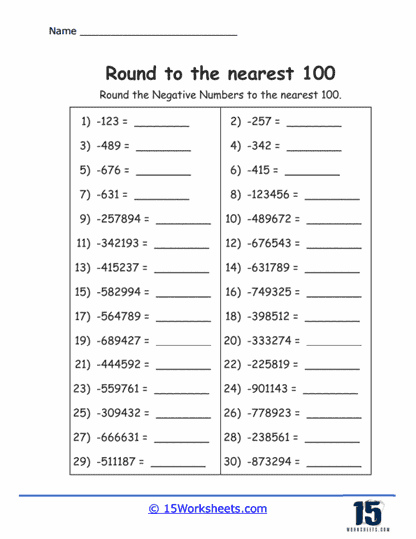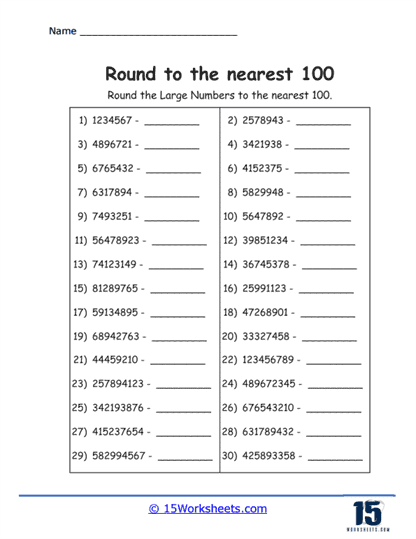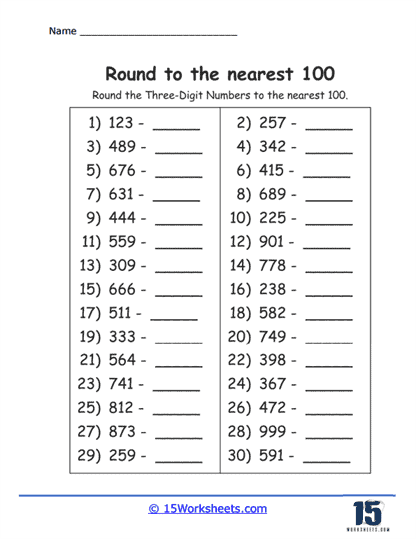Round to the Nearest 100 Worksheets
About These 15 Worksheets
These worksheets can help students practice and master the concept of rounding numbers, a fundamental math skill that is essential in both academic settings and real-world applications. These worksheets present a variety of scenarios that challenge students to apply rounding principles to different types of numbers and contexts, ensuring a deep and comprehensive understanding of the topic.
One of the core components you’ll find on these worksheets is the simple task of rounding two-digit, three-digit, or larger numbers to the nearest 100. This type of exercise is foundational, as it helps students get comfortable with the basic mechanics of rounding by identifying the closest multiple of 100 to a given number. For instance, students might be asked to round numbers like 57 or 89, helping them grasp how to move up or down to the nearest hundred, based on the value in the tens place. The repetition of such tasks is crucial because it reinforces the idea that rounding is about finding the most approximate value that simplifies a number, which is especially useful in estimation and mental math.
Another type of problem on these worksheets involves rounding large numbers, often stretching into the thousands, ten-thousands, or even higher. These exercises introduce students to more complex numbers, where they must still apply the same basic rounding principles but within a broader numerical context. By working through these problems, students learn to extend their rounding skills beyond simple two-digit numbers and apply them to much larger figures, which is a necessary skill for higher-level math and everyday situations involving big numbers, such as finances or data analysis.
The worksheets also incorporate exercises where students must round numbers and then compare the rounded figure to the original number. This type of problem is particularly effective in helping students understand the impact of rounding. It encourages them to think critically about how rounding changes a number and why certain numbers are rounded up while others are rounded down. By comparing the original and rounded numbers, students get a clearer picture of the rounding process and its consequences, which enhances their overall mathematical reasoning.
In addition to these standard rounding tasks, some worksheets integrate word problems that require rounding to the nearest 100. These word problems are designed to simulate real-life scenarios where rounding is necessary. For example, students might encounter a problem where they need to round the number of books in a library or the number of visitors to a museum. These types of problems help students see the practical applications of rounding and understand why it is an important skill to develop. Word problems also challenge students to apply their rounding skills in a more complex and contextualized manner, making the learning experience richer and more engaging.
Another creative approach found in these worksheets is the use of rounding in a color-by-number activity. In such exercises, students must first round each number to the nearest 100 and then use a color code to fill in shapes based on their answers. This not only reinforces their rounding skills but also adds an element of fun and creativity to the learning process. Activities like this are particularly effective for younger students or those who benefit from visual and hands-on learning, as they combine mathematical practice with art, making the exercise both educational and enjoyable.
Matching exercises are also common in these worksheets. In these tasks, students are given a list of numbers and must match each one with its rounded counterpart. This type of activity is excellent for quick practice and review, as it requires students to actively engage with the numbers and think on their feet. Matching exercises are often timed or competitive, which adds a level of excitement and challenge to the learning process, encouraging students to improve their speed and accuracy in rounding.
Multiple-choice questions are another feature you might find on these worksheets. In these problems, students are presented with a number and several possible answers, one of which is the correct rounded value. Multiple-choice questions are useful for assessing a student’s understanding of rounding concepts in a format that is both straightforward and easy to grade. These questions also help students practice their test-taking skills, as they must quickly and accurately choose the correct answer from several options.
One more advanced type of exercise involves rounding numbers before performing additional operations, such as addition or subtraction. For example, a worksheet might ask students to round two numbers to the nearest 100 and then add them together. This type of problem not only reinforces rounding skills but also integrates them with other areas of math, such as arithmetic. By combining rounding with addition or subtraction, students learn to see how rounding can be used as a tool to simplify calculations, making it a practical skill in a variety of mathematical contexts.
You will also find comparison exercises that ask students to round a number and then compare it with the original. These types of problems are particularly valuable because they teach students about the concept of relative size and how rounding can affect numerical relationships. By comparing numbers before and after rounding, students gain a deeper understanding of the rounding process and how it can be used to estimate and simplify numbers in a meaningful way.

